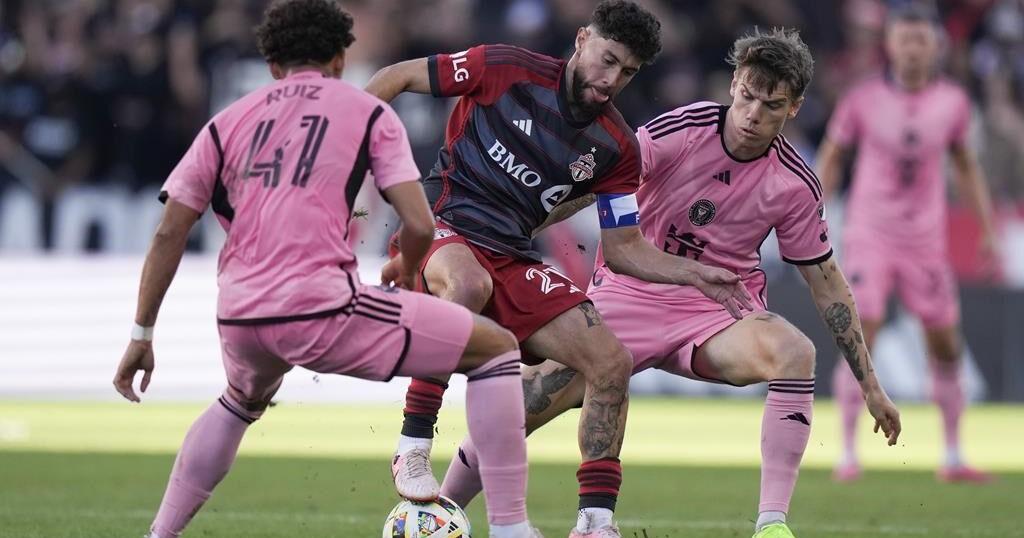TORONTO – Leo Campana scored in stoppage time to leave Toronto FC‘s playoff hopes hanging by a thread after a 1-0 Inter Miami win Saturday.
The Ecuador forward controlled a Luis Suarez cross with his leg, turned and hammered a shot past goalkeeper Sean Johnson for a highlight-reel winner in the 93rd minute — his eighth goal of the season.
Toronto entered weekend play in ninth place in the East, the last available post-season berth, needing a win over Miami and help elsewhere to keep its playoff hopes alive. The game ended with TFC knowing a win or draw by either Philadelphia (at Columbus) or D.C. United (at New England) later in the day would end its post-season hopes.
Toronto outshot Miami 15-4 (7-2 in shots on target).
It looked like the game was destined to end a scoreless draw with an understrength Miami side keeping Lionel Messi and other stars on the bench to start.
The 37-year-old Argentine captain was the main attraction, prompting chants of “Messi, Messi” and turning up the volume when he finally came on in the 61st minute at BMO Field.
He drew cheers when he paused to allow a young pitch invader to take a selfie with him in the 86th minute. An older fan did not get the same welcome seconds later when he ran on the pitch.
With an Oct. 19 bye, Toronto (11-9-4) will have to watch the league’s final regular-season slate of games from the sidelines.
Miami (21-4-8) arrived on a high, coming off a 3-2 mid-week win at Columbus clinching the Supporters’ Shield that goes to the team with the league’s best regular-season record.
The win means Miami, with 71 points and a game remaining, is still on track for the league’s single-season points record of 73, set in 2021 by New England.
With first place in the MLS’s Eastern Conference already secured, Miami coach Tata Martino opted to keep Messi, Suarez and fellow star Sergio Busquets, Jordi Alba and goalkeeper Drake Callender among the substitutes to start. With a combined salary of some US$33 million, it made for a big-ticket Miami bench.
But Messi’s pink Miami and blue Argentina jerseys, as well as a few from his FC Barcelona era, were on display in the crowd. And all eyes were on the Miami bench rather than the starters when the players came out.
The BMO Field crowd rose and cheered in the 48th minute as Messi left the bench to warm up with the other Miami substitutes.
Messi and Busquets came on to cheers together. Suarez entered the game 10 minutes later, in the 71st minute.
While Messi’s every touch drew a response from the announced crowd of 30,217 — his blocked shot drew aahs in the 68th minute — that was about the only drama in a drab game.
Toronto’s lack of a cutting edge was evident up front, with Federico Bernardeschi suspended and an ailing Lorenzo Insigne restricted to an 11-minute cameo. Still Toronto offered more in attack than the makeshift visitors’ side.
Miami made 10 changes to the starting lineup that defeated Columbus in a game that mattered.
Messi, Suarez and Busquets did not take part in Miami’s 2-1 win at Vancouver on May 25, disappointing an announced crowd of 51,035 at B.C. Place Stadium. The three started in Miami’s 3-2 win in Montreal on May 11 before 19,619 at Saputo Stadium.
Messi and Suarez arrived with 35 league goals between them, just five fewer than Toronto’s entire total for the season.
Messi, who had played the last five games after returning from injury, joins Argentina next for World Cup qualifiers against Venezuela next week during the FIFA international window.
Toronto was three points behind CF Montreal which had played one fewer game. Philadelphia and D.C. United (both 9-13-10) were also on 37 points — trailing TFC on a tiebreaker (most wins) — but also had a game in hand.
The eighth- and ninth-place clubs meet in a wild-card playoff with the winner advancing to face the conference’s top seed — Miami in the East — in a best-of-three first-round matchup.
The best Toronto could do was win Saturday and hope others stumble in the final stretch. But there were more bad scenarios than good.
Toronto coach John Herdman made five changes to his starting lineup, slotting in Franklin, Nicksoen Gomis, Sigurd Rosted, Matty Longstaff and Alonso Coello.
Toronto was also without injured defenders Kevin Long (concussion) and Kosi Thompson (knee).
Toronto had lost three of it last four league outings (0-3-1) and gone 3-5-1 since a 3-1 loss at Miami on July 17.
Miami was unbeaten in its last nine league outings (6-0-3). Its last league defeat was July 6, a 6-1 loss at Cincinnati.
This report by The Canadian Press was first published Oct. 5, 2024.
Follow @NeilMDavidson on the X platform, formerly known as Twitter.

























